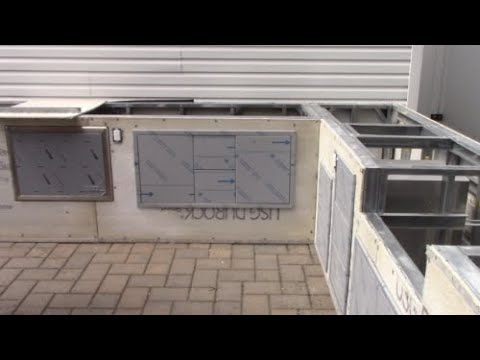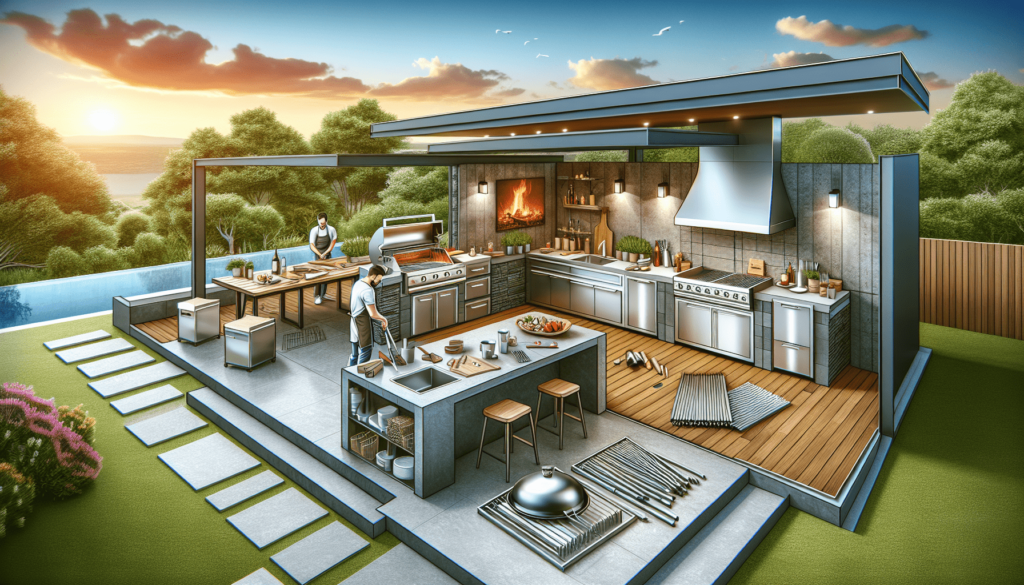In this amazing DIY outdoor kitchen tutorial, Let’s DIY 2gether takes you through all the steps to build your own outdoor kitchen. From planning and design to installing drawers and cement boards, this video has got you covered. And that’s not all, in part 2, you’ll also learn about bbqguys.com, LED low voltage lighting, Bull Grill, Cambridge stone, burner, drawers, cement board, and plenty of counter space. So if you’ve been dreaming of having your own outdoor kitchen, this video is a must-watch. Let’s DIY 2gether provides valuable tips and advice on material choices, measurements, framing, and tools, making it easier for you to create a kitchen like their fantastic creation. Get ready to elevate the value of your home and enhance your entertainment experience with a stylish and functional outdoor kitchen.
Planning and Design
Importance of planning
Planning is a crucial step when it comes to building an outdoor kitchen. It allows you to visualize the space and ensure that everything fits correctly. By drawing everything out and taking accurate measurements, you can avoid any potential issues that may arise during the construction process. Planning also helps you determine the correct space needed for inserts, drawers, access doors, and the grill, ensuring that you have enough room for all of your desired components.
Drawing out the kitchen
Once you have gathered all the necessary measurements, it’s time to start drawing out your outdoor kitchen. This step allows you to create a top view of the kitchen, accurately representing the dimensions of the space. By drawing everything on paper, you can get a better idea of how the final kitchen will look and operate. Make sure to include all your desired components and consider the flow of the kitchen to ensure optimal functionality.
Measuring for inserts
When it comes to the inserts in your outdoor kitchen, precision is key. Before framing the kitchen, take the time to measure two or three times according to the specifications provided by the manufacturer. This will help you avoid any issues when it comes time to install the inserts. Double-checking your measurements ensures that everything will fit securely and function properly within the kitchen.
Reinforcing the grill area
The grill is one of the heaviest components in an outdoor kitchen, so it needs ample support. When framing around the grill, it is essential to reinforce the area to ensure its stability and prevent any potential issues down the line. By reinforcing the grill area, you can alleviate stress on the structure and ensure that it can withstand the weight of the grill. Consider using additional support beams or braces to provide extra strength and stability.
Materials and Tools

Track and studs
When it comes to framing your outdoor kitchen, using the right materials is vital. Track and studs are commonly used for framing, and you can find them at any home improvement store. The track provides a stable base for the studs, allowing for easy installation and adjustment as needed. Make sure to choose track and studs made of durable materials like galvanized steel to ensure the longevity of your outdoor kitchen.
Liquid nail
Liquid nail is a heavy-duty adhesive that is commonly used in construction projects. It is particularly useful when installing cement boards for your outdoor kitchen. Applying liquid nail to the back of the boards helps ensure a secure and strong bond, providing stability and preventing any potential movement or shifting.
Aviator clips
Aviator clips are handy tools when it comes to cutting metal studs. They provide a clean and precise cut and make the process much easier. These clips are a great addition to your tool arsenal when working with metal studs for framing your outdoor kitchen.
Pan head screws
Pan head screws, specifically 7 by 7/16 screws, are ideal for attaching metal studs together. They are small but mighty, offering a secure hold without the need for excessive length. By using pan head screws, you can ensure that your metal studs stay firmly in place, creating a strong and sturdy frame for your outdoor kitchen.

Grinder
A grinder is a versatile tool that comes in handy when working with cement boards. While a circular saw can cut most of the cement boards, a grinder is useful for more precise cuts. Whether you need to trim or shape the boards, a grinder allows you to achieve the desired shape and size effectively.
Circular saw
A circular saw is an essential tool when it comes to cutting cement boards for your outdoor kitchen. It is capable of making straight, clean cuts, making the installation process much easier. When using a circular saw, ensure that you have the appropriate safety gear and take proper precautions to prevent any accidents.
Grips for holding cement boards
Holding the cement boards securely in place while cutting them is crucial to achieving accurate and precise cuts. Grips, or clamps, are essential tools that help keep the boards steady during the cutting process. By utilizing grips, you can maintain stability and ensure clean cuts, resulting in a professional-looking finish for your outdoor kitchen.
Horses for cutting cement boards
To facilitate easier and cleaner cuts, setting up horses to hold the cement boards is highly recommended. Horses provide a stable surface for cutting the boards, allowing for better control and accuracy. By setting up horses, you can ensure that your cuts are straight and smooth, making the installation process much simpler.

Two and a half 20-gauge steel for framing
Using the right materials for framing is crucial for the structural integrity of your outdoor kitchen. Two and a half-inch 20-gauge galvanized steel is a recommended choice for framing. This material is durable, corrosion-resistant, and provides the necessary strength and stability for your outdoor kitchen’s frame.
Half-inch cement board
For the walls and surfaces of your outdoor kitchen, half-inch cement boards are commonly used. These boards are sturdy and weather-resistant, making them an ideal choice for an outdoor setting. Ensure that you secure the cement boards properly using adhesive and screws to create a solid foundation for your kitchen.
Framing the Kitchen
Using the track for framing
The track plays a vital role in framing your outdoor kitchen. By using a one-inch track, you create a slight gap between the frame and the floor, allowing for proper airflow and water runoff. This helps prevent any potential moisture damage and ensures that your kitchen remains in good condition for years to come. The track also provides a secure base for the studs, making the overall framing process much easier.
Ensuring air flow and water runoff
Proper airflow and water runoff are essential factors to consider when constructing an outdoor kitchen. Adequate air circulation helps prevent any buildup of heat or moisture, ensuring a comfortable and safe cooking environment. Additionally, water runoff is crucial to prevent any potential water damage or pooling. By ensuring proper air flow and water runoff, you can create an outdoor kitchen that is functional and long-lasting.

Framing around the inserts and grill
Once the basic frame is in place, it’s time to frame around the inserts and grill. Take accurate measurements according to the specifications provided by the manufacturer, ensuring a proper fit for each component. Pay special attention to the area around the grill, reinforcing it to support the excessive weight. By framing meticulously around the inserts and grill, you can ensure that everything fits securely and functions properly within your outdoor kitchen.
Reinforcing the grill area
As mentioned earlier, reinforcing the grill area is crucial due to the heavy weight of the grill. Consider using additional support beams or braces to provide extra strength and stability. By reinforcing the grill area, you minimize the risk of any structural issues and create a safe environment to enjoy outdoor cooking.
Cutting and Installing Cement Boards
Using a circular saw and grinder to cut cement boards
Cutting cement boards to the desired size and shape may require the use of both a circular saw and a grinder. A circular saw is excellent for straight cuts and can quickly trim down the boards to fit your needs. However, a grinder may be necessary for more precise cuts, especially for shaping corners or curves. By utilizing these tools effectively, you can ensure that the cement boards fit perfectly into your outdoor kitchen.
Leaving quarter-inch spacing for water runoff
When installing cement boards, it is essential to leave a quarter-inch spacing between each board. This spacing allows for proper water runoff, preventing any potential damage or pooling. By providing adequate space for water to escape, you can maintain the integrity of your outdoor kitchen and prevent any moisture-related issues in the future.

Installing cement boards with glue
To ensure a secure and long-lasting installation, it is recommended to use adhesive glue to attach the cement boards. Liquid nail, specifically heavy-duty adhesive, is an excellent choice for this purpose. Apply the adhesive to the back of the boards before placing them in position. This will help create a strong bond, preventing any movement or shifting and ensuring that the boards stay in place for years to come.
Electrical and Plumbing
Running electric and gas lines
Proper electrical and gas lines are crucial for the functionality of your outdoor kitchen. Plan and run these lines accordingly, considering the location of your components and appliances. It is recommended to hire a professional electrician and plumber to ensure that all connections are done safely and up to code.
Installing outlets and switches
Ensure that you have sufficient outlets and switches installed in your outdoor kitchen to accommodate your various appliances and lights. By having these electrical components strategically placed throughout the kitchen, you can easily access power when and where you need it. Consider using waterproof or weather-resistant outlets and switches to protect them from the elements.
Installing a transformer for low voltage lights
Low voltage lights can add a beautiful ambiance to your outdoor kitchen. To install these lights, you will need a transformer to deliver the appropriate voltage. The transformer converts the higher voltage from your main power source to a lower, safer voltage for the lights. Make sure to wire the transformer correctly and consider placing it in an accessible location for maintenance and adjustments.
Connecting gas lines with valves
Connecting gas lines requires attention to detail and proper safety precautions. Ensure that you follow local building codes and regulations when installing gas lines for your outdoor kitchen. It is crucial to use high-quality materials, such as pipes and valves, to ensure a safe and secure connection. It is highly recommended to hire a professional plumber to handle the installation of gas lines and valves.
Reinforcing and Preparing for Countertop
Double reinforcing areas for heavy equipment
To support heavy equipment, such as a grill or refrigerator, it is essential to double reinforce the areas where they will be placed. This can be accomplished by adding additional support beams or braces underneath these specific areas. By providing ample reinforcement, you can ensure that your outdoor kitchen can handle the weight of these appliances without any issues.
Preparing for granite or stone countertops
If you plan to install granite or stone countertops in your outdoor kitchen, proper preparation is crucial. Ensure that the frames and supports are appropriately positioned to accommodate the weight of the countertops. Take accurate measurements and plan for cutouts or holes where necessary, such as for sinks or other fixtures. Proper preparation will make the installation of the countertops much smoother and more secure.
Cutting holes for water and drain
If you will be incorporating a sink into your outdoor kitchen, it is important to cut the appropriate holes for water and drainage. Measure and mark the locations of these holes accurately to ensure a proper fit. It is recommended to use a drill with the appropriate hole saw attachment for this task. Take your time to make clean and precise cuts, allowing for a seamless installation of the sink.
Ordering Equipment
Ordering from BBQ Guys
When it comes to selecting equipment for your outdoor kitchen, BBQ Guys is a reputable option to consider. They offer a wide range of high-quality products, including grills, burners, drawers, and more. Take the time to research and browse their selection to find the suitable equipment for your specific needs and preferences. By ordering from BBQ Guys, you can trust that you are getting reliable and durable products for your outdoor kitchen.
Selecting appropriate equipment for the outdoor kitchen
When selecting equipment for your outdoor kitchen, it’s important to consider your specific needs and preferences. Determine the type of grill, burner, drawers, and other components that will meet your cooking style and requirements. Take into account factors such as size, fuel type, functionality, and durability. By carefully selecting the appropriate equipment, you can create an outdoor kitchen that meets all your culinary needs and desires.
Cutting and Installing Countertops
Cutting and fitting the countertop to the kitchen
Once you have ordered your chosen countertops, it’s time to cut and fit them to your outdoor kitchen. Carefully measure the dimensions of the kitchen space and mark your countertop accordingly. Use a precise cutting tool, such as a circular saw or a diamond blade, to ensure a clean and accurate cut. Take your time during this process to achieve a seamless and professional finish.
Installing the countertop onto the frame
After cutting the countertop to size, it’s time to install it onto the frame of your outdoor kitchen. Ensure that the frame is level and secure before placing the countertop on top. Use appropriate adhesive or securing methods recommended by the manufacturer to secure the countertop in place. Take extra care when handling and maneuvering the countertop to prevent any damage during the installation process.
Stone Work
Finishing the kitchen with stone
Stone work is a fantastic way to add a beautiful and natural finish to your outdoor kitchen. Consider using stone veneers or natural stone to create a cohesive and appealing look. Stone can be applied to the walls, pillars, or any other surface you desire. It is recommended to hire a professional stone worker or follow detailed instructions to ensure proper installation and an aesthetically pleasing result.
Creating a cohesive look with stone work
When incorporating stone work into your outdoor kitchen, it is important to create a cohesive look that complements the overall design. Consider using the same type or color of stone throughout the kitchen to ensure consistency. Pay attention to the placement and arrangement of the stones to achieve a balanced and visually pleasing appearance. By creating a cohesive look with stone work, you can enhance the overall aesthetic and appeal of your outdoor kitchen.
Conclusion
Reviewing the steps taken so far
In this article, we have discussed the importance of planning and design when building an outdoor kitchen. We have explored the process of drawing out the kitchen and measuring for inserts. We have also covered the steps involved in reinforcing the grill area and framing the kitchen using track and studs. Additionally, we have discussed the materials and tools needed, such as liquid nail, aviator clips, and pan head screws. We have explained the process of cutting and installing cement boards, as well as the importance of proper electrical and plumbing installations. Furthermore, we have touched on reinforcing and preparing for countertops, ordering equipment from BBQ Guys, and cutting and installing countertops. Finally, we have discussed the finishing touches of stone work and creating a cohesive look.
Looking forward to Part 2 of the DIY outdoor kitchen project
Building an outdoor kitchen is an exciting and rewarding project. In Part 1, we have covered the essential steps to get you started on creating your dream outdoor kitchen. However, there is still more to come in Part 2. In the next part of this DIY series, we will delve into topics such as bbqguys.com, LED low voltage lighting, Bull Grill, Cambridge stone, burners, drawers, and plenty of counter space. Stay tuned for the next installment, where we will explore these aspects of building an outdoor kitchen in more detail.
